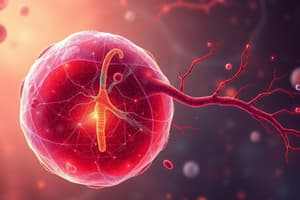Podcast
Questions and Answers
Where does aerobic respiration primarily take place?
Where does aerobic respiration primarily take place?
- Mitochondria (correct)
- Cytoplasm
- Nucleus
- Endoplasmic reticulum
What is the primary energy source for cells in aerobic respiration?
What is the primary energy source for cells in aerobic respiration?
- Water
- Carbon dioxide
- Lactic acid
- Glucose (correct)
Under what conditions does anaerobic respiration typically occur?
Under what conditions does anaerobic respiration typically occur?
- In the presence of oxygen
- At rest and during sleep
- During intense physical activity (correct)
- In well-ventilated environments
Which protein in red blood cells is responsible for binding and transporting oxygen throughout the body?
Which protein in red blood cells is responsible for binding and transporting oxygen throughout the body?
What serves as the primary site for gas exchange in the human respiratory system?
What serves as the primary site for gas exchange in the human respiratory system?
How is carbon dioxide primarily transported in the blood?
How is carbon dioxide primarily transported in the blood?
What is the function of the alveoli in the respiratory system?
What is the function of the alveoli in the respiratory system?
Which part of the respiratory system controls involuntary breathing?
Which part of the respiratory system controls involuntary breathing?
What happens during inhalation in the breathing process?
What happens during inhalation in the breathing process?
Which of the following statements is true about voluntary breathing?
Which of the following statements is true about voluntary breathing?
What is the function of the trachea in the respiratory system?
What is the function of the trachea in the respiratory system?
Which process involves the breakdown of glucose in the presence of oxygen to produce energy?
Which process involves the breakdown of glucose in the presence of oxygen to produce energy?
Flashcards are hidden until you start studying
Study Notes
Respiration: The Essential Exchange between Life and Air
The human respiratory system is a marvel of design, enabling us to breathe and sustain life through a continuous exchange of gases. This article delves into the inner workings of this vital system, covering the respiratory structures, mechanisms, and the crucial processes of aerobic and anaerobic respiration.
The Respiratory System
The respiratory system primarily consists of the nose, nasal passages, mouth, pharynx, larynx, trachea, and lungs. This network of organs and passageways allows us to inhale air, extract oxygen, remove carbon dioxide, and exhale waste gases. The lungs themselves consist of millions of tiny air sacs called alveoli, which provide the surface area necessary for efficient gas exchange.
Breathing Mechanisms
The respiratory system employs two mechanisms to facilitate breathing: involuntary and voluntary. Involuntary breathing, a process called respiration, is controlled by the brainstem and happens automatically, while voluntary breathing allows for controlled breath-holding and deep breathing.
Inhalation occurs as the diaphragm, a large dome-shaped muscle, contracts and moves downward, creating a vacuum in the thoracic cavity that draws air into the lungs. Exhalation results from the relaxation of the diaphragm, which rises, and the contraction of the intercostal muscles, which compress the thoracic cavity, expelling air.
Aerobic vs Anaerobic Respiration
Respiration can be categorized into two types: aerobic and anaerobic.
Aerobic respiration is a process that involves the use of molecular oxygen, allowing cells to release large amounts of energy through the breakdown of glucose. This process takes place in the mitochondria, where a series of chemical reactions occur, ultimately resulting in the production of adenosine triphosphate (ATP), the primary energy source for cells.
Anaerobic respiration, on the other hand, occurs in the absence of molecular oxygen and produces less energy than aerobic respiration. This process is essential under extreme conditions when oxygen availability is limited, such as during intense physical activity or in certain types of cells.
Gas Exchange and Blood
Gas exchange is the process by which oxygen is absorbed from the air and transported to cells, and carbon dioxide is removed from cells and released into the air. This process occurs primarily in the alveoli, where oxygen diffuses through the alveolar membrane into the bloodstream, and carbon dioxide diffuses out of the blood into the alveoli.
The primary vehicle for gas exchange is red blood cells, which contain a protein called hemoglobin, which binds to oxygen and transports it throughout the body. Carbon dioxide, a waste product of cellular respiration, is transported by red blood cells as bicarbonate ions or dissolved directly in the blood.
Conclusion
The human respiratory system, a marvel of biological engineering, is responsible for the vital exchange of gases essential for life. Understanding the complex processes of gas exchange, aerobic and anaerobic respiration, and the role of blood in transporting gases is fundamental to our appreciation of this system and the importance of maintaining optimal respiratory health.
Studying That Suits You
Use AI to generate personalized quizzes and flashcards to suit your learning preferences.




